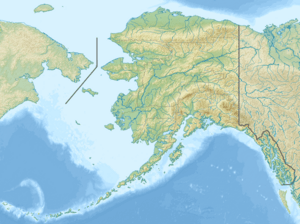Agiapuk River facts for kids
Quick facts for kids Agiapuk River |
|
|---|---|
|
Location of the mouth of the Agiapuk River in Alaska
|
|
| Other name(s) | Agee-ee-puk, Ageepuk, Agiopuk, Ahgeeapuk |
| Country | United States |
| State | Alaska |
| District | Nome Census Area |
| Physical characteristics | |
| Main source | Seward Peninsula Northeast of Black Mountain 1,188 ft (362 m) 65°33′28″N 166°29′45″W / 65.55778°N 166.49583°W |
| River mouth | Imuruk Basin, Bering Sea 21 miles (34 km) southeast of Teller 7 ft (2.1 m) 65°09′59″N 165°41′02″W / 65.16639°N 165.68389°W |
| Length | 60 mi (97 km) |
The Agiapuk River is a waterway located on the Seward Peninsula in Alaska, United States. It is also known by other names like Agee-ee-puk and Ageepuk. This river flows into Grantley Harbor from the north. A major stream that feeds into it is the American River.
Contents
Exploring the Agiapuk River's Geography
The Agiapuk River flows into the Imuruk Basin from the north. It drains a large area of land in the middle of the Seward Peninsula. This area is about 800 to 1,000 square miles (2,100 to 2,600 square kilometers).
River Branches and Landscape
About 20 miles (32 km) north of Imuruk Basin, the Agiapuk River splits into two main branches. The eastern branch is larger and is called the American River. The western branch keeps the name Agiapuk.
Below where the river splits, the Agiapuk River winds a lot. It flows across a wide, flat area called a flood plain. From this flat land, the ground gently rises to hills with flat tops. These hills are usually between 600 and 800 feet (180 and 240 meters) high.
The Western Branch and Surrounding Land
The western branch of the Agiapuk River flows through a wide, low area. This area stretches for about 20 miles (32 km) next to Grantley Harbor and Port Clarence. A higher piece of land, about 1,000 feet (300 meters) high, separates it from the harbor.
Near its western end, this low area is about 500 feet (150 meters) high and 5 miles (8.0 km) wide. The California River also flows through part of this low area. It has carved a new, deep canyon. Flat-topped mountains, reaching 1,000 to 1,800 feet (300 to 550 meters) high, border this low area to the north. The main Agiapuk River comes out of a narrow valley in these mountains and enters this lower region.
Riverbed and Rocks
The Agiapuk Valley, below the forks, is filled with gravel from floods. These gravels extend far up the river. It is thought that these gravels fill a low area that was once a lake or an arm of the sea. Over time, it filled up with sediments.
Where the California River cuts through the upper end of this low area, you can see the solid rock beneath the soil. This solid rock is called bedrock. Between the Agiapuk River and Grantley Harbor, the bedrock includes schist and limestone. There are also younger rocks called basalt. North of the Agiapuk, the bedrock is made of Silurian limestones. These limestones are mostly unchanged and do not contain many minerals.


